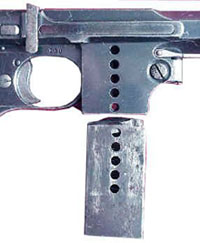Although the Bergmann 1896 model worked fairly well, it did not gain real popularity, primarily because it was less effective than the Mauser which came on the market at about the same time. Apart from small, pocket arms, it was clear that by then the main requirement for self-loading pistols would be for military use.
be for military use.
As these pistols were required to fire a more powerful cartridge, it was necessary that they would fire with the breech locked. If this was not done, the cartridge case would be pushed out of the chamber when the gas pressure was still high and, unsupported by the walls of the chamber, it was likely to rupture.
So in 1897, Bergmann patented a pistol of the type shown here. In this design the barrel and bolt were locked together at the instant of firing and remained so during the first 0.25 inch of recoil. A cam in the frame then forced the bolt slightly sideways and unlocked it from the barrel, which then stopped. The bolt continued to the rear, cocking the hammer, and then came forward, taking a round from the magazine, chambering it, locking on to the barrel, and forcing it back to its forward firing position.
The magazine was a detachable box, incorporating its own platform and spring. However, the pistol could also be loaded through the top of the frame by means of a charger. Much to Bergmann's disappointment, no country adopted this arm, although several experimented with it.